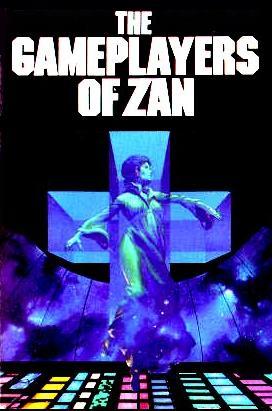The Gameplayers of Zan (1977) is one of those books where I find myself wondering however anyone could have started from a blank piece of paper and come up with the idea. It’s weird, and it’s alien, and it is a very odd book indeed.
The Ler are an artificially created race, made from human DNA but at the next stable point along the evolutionary chain. (Handwave, handwave.) They have five fingers and two thumbs on each hand, they have a very different reproductive cycle, and they have developed their own initially artificial but very distinct culture. At the time of the novel, 2550, there have been fourteen generations of Ler living on their reservation, reproducing in their own natural way, a hundred thousand of them surrounded by twenty billion humans. Human culture is itself very different from anything we might expect. This is one of the things that makes the book so odd. The Ler are not held up in contrast to humanity as we know it, these humans are harder to identify with than the Ler are, and the Ler are pretty strange. The effect of the book is like taking an immersion course in the alien.
The book plunges us into the Ler from the beginning. There are, oddly, footnotes. It’s like reading a translation. We’re given Ler words and concepts, translated once and then used untranslated. We begin with a Ler girl who knows something (we don’t know what, and it’s one of the central mysteries of the book) who is in a sensory deprivation environment and who chooses to “autoforget” to delete her memories, which Ler can. Then we jump to Fellirian and Morlenden of the Deren braid, the real protagonists, who are asked to search for the missing girl. The question of who she is and what she knew are the hook that lead us through Ler society and Ler interaction with the human world.
Ler society is really fascinating, and this is really what draws me back to this book. The Ler have thirteen years of childhood, followed by about seventeen years of infertile adolescence, followed by about fifteen years of fertility, followed by about sixty years of infertile elderhood. To maximise fertility, in which Ler get two, or occasionally three, births, they form not families but “braids” which have four parents, and four (sometimes five) children, an elder outsibling, born to the insibling pair of the previous generation, then two insiblings, whose parents are one of the previous generation’s insiblings and one married in afterparent, then a younger outsibling, born to the two afterparents. Everyone has to be the right age. The two outsiblings will marry out, the two insiblings will stay in the braid and carry it on. They are of no genetic relation, but are brought up as siblings. It sounds really odd, and it is, but Foster shows you how it works for individual characters. It wouldn’t work for humans, but humans don’t have the problem of needing to maximize fertility and mix genes, rather the opposite. Humans in Foster’s future have been through one Malthusian crisis already.
The braids also pursue a traditional occupation. The Derens are record-keepers. We also hear of potters and weavers. The Ler, whose first generation were raised in human labs, have made a deliberate choice to live in a primitive way. They’re not supermen, and they’re not real aliens, but they are very different. And they’re quite distinct from any “primitive” historical human societies, though they’ve clearly taken aspects from different culures and made them their own. They’re using high technology for some things while choosing to live in the woods and carry water.
Humans meanwhile are suspicious—not just of the Ler but of each other. They live in shifts, in dormitories, they’re mostly not allowed to reproduce, they live with a high level of surveillance and control, they take programmed names so people can’t guess their origin, and they’re given points for betraying each other. They’re paranoid, scheming, unhappy, whereas the Ler we see have a kind of solidity and balance to their lives even when they’re miserable that’s entirely lacking among the humans.
We follow Fellirian and Morlenden through fascinating Ler society and the quest for the missing girl, and eventually discover that—as in Bujold’s “The Borders of Infinity“—the whole thing has been an elaborate smokescreen disguising an escape plan. The Ler, unknown to the humans and most of their own people, are growing a spaceship to take them off Earth. This is an appropriate solution to the quest plot, it explains all the mysteries, it opens up the way to the two sequels, where humans and Ler are in space, and it really isn’t what’s important. What I like about the book is the alien details—the way the braids are woven, the “wayyon” or wander-year the insiblings take in the year before fertility, the madness of Sanjirmil.
The sequels, all included in the new edition, are weird. The Warriors of Dawn was written before Gameplayers, though it’s set later, and is much less accomplished as a novel. The Day of the Klesh is well written but too odd for me. I’ve read both of them several times, but I haven’t read either of them for a long time. When I feel drawn back to the Ler I mostly just re-read Gameplayers.










